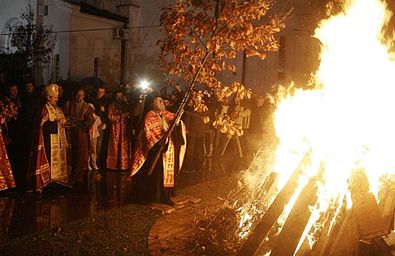
The badnjak (Serbian Cyrillic: бадњак, pronounced [bǎdɲaːk]), also called veseljak (весељак, pronounced [ʋɛˈsɛ̌ʎaːk], literally "the one who brings joy" in Serbian), is a tree branch or entire tree that is central to Serbian Christmas celebrations. It is placed on a fire on Christmas Eve[Note 1] and its branches are later brought home by worshipers. The tree from which the badnjak is cut, preferably a young, straight and undamaged Oak, is ceremonially felled early on the morning of Christmas Eve. The felling, preparation, bringing in, and laying on the fire, are surrounded by elaborate rituals, with many regional variations. The burning of the log is accompanied by prayers that the coming year brings food, happiness, love, luck, and riches. The log burns on throughout Christmas Day, when the first visitor strikes it with a poker or a branch to make sparks fly, while wishing that the family's happiness and prosperity be as abundant as the sparks. As most Serbs today live in towns and cities, the badnjak is often symbolically represented by a cluster of oak twigs with brown leaves attached, with which the home is decorated on Christmas Eve.
Since the early 20th century, the Serbian badnjak tradition has also been celebrated more publicly. Before World War I, soldiers of the Kingdom of Serbia developed the custom of laying a badnjak on a fire in their barracks. In the succeeding Kingdom of Yugoslavia, the military badnjak ceremony was further elaborated and standardized in army service regulations, but the tradition ended at the outbreak of World War II. Since the early 1990s, the Serbian Orthodox Church has, together with local communities, organized public celebrations on Christmas Eve in which the badnjak plays a central role. Parishioners festively cut the sapling to be used as the badnjak and take it to their church, where it is consecrated by a priest before being ceremonially placed on a fire pit in the churchyard.
The festive kindling of the badnjak commemorates the fire that—according to Serbian folk tradition—the shepherds of Bethlehem built in the cave where Jesus was born, to warm the Baby Jesus and his mother throughout the night. The badnjak may also be seen as a symbol of the cross upon which Christ was crucified, the warmth of its fire symbolizing the salvation which, in the Christian belief, the crucifixion made possible for mankind. Scholars regard the tradition as inherited from the old Slavic religion. They interpret the badnjak as an incarnation of the spirit of vegetation, and as a divinity who dies by burning to be reborn, to whom sacrifices and prayers were offered for the fertility of fields, the health and happiness of the family. The burning symbolized sunshine, securing the vitalizing power of the sun in the coming year. Other South Slavic peoples have similar traditions, and the custom that a family brings a log into the house and burns it on Christmas Eve has also been recorded in other parts of Europe.
Cite error: There are <ref group=Note> tags on this page, but the references will not show without a {{reflist|group=Note}} template (see the help page).